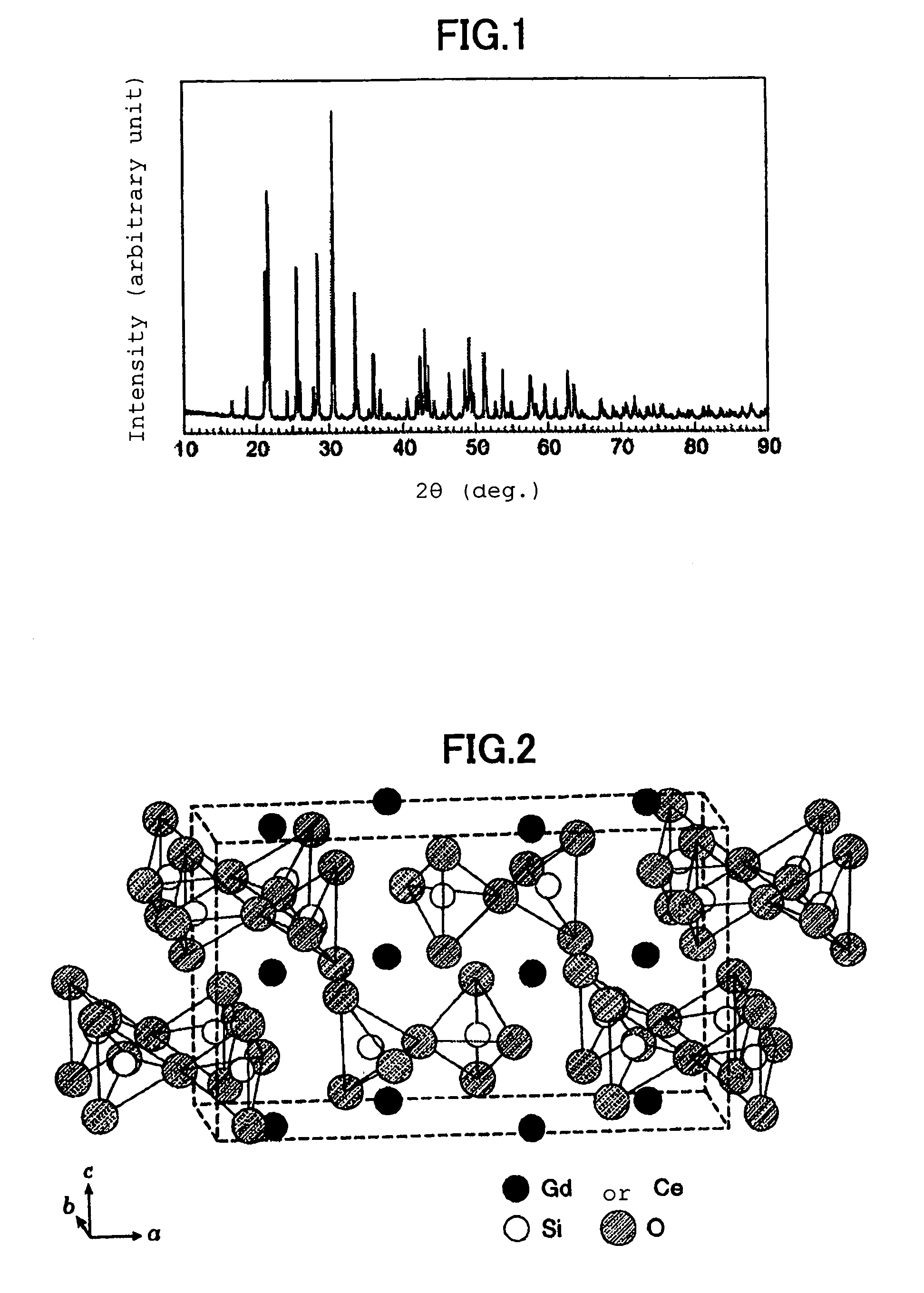Fluorescent substance and fluorescent composition containing the same
a technology of fluorescent composition and fluorescent substance, which is applied in the direction of radiation intensity measurement, instruments, x/gamma/cosmic radiation measurement, etc., can solve the problem of high cost of single crystal material, and achieve excellent processability and high light-emitting power
- Summary
- Abstract
- Description
- Claims
- Application Information
AI Technical Summary
Benefits of technology
Problems solved by technology
Method used
Image
Examples
example 1
[0035]A fluorescent substance was prepared according to the following method while selecting Gd and Ce as the constituent elements A and B of the composition according to the present invention and aiming at 0.05 for the value x.
[0036]There were prepared gadolinium (3+) nitrate hexahydrate, cerium (3+) nitrate hexahydrate and tetraethyl orthosilicate as raw materials for Gd, Ce and Si components, respectively. To 40 ml of an ethanol solution of a silica sol comprising 8.33 g of tetraethyl orthosilicate, 1 ml of water and 2 ml of a 1M hydrochloric acid solution, there were added 152 ml of a 0.25 mole % aqueous solution of the foregoing gadolinium (3+) nitrate hexahydrate and 20 ml of a 0.1 mole % aqueous solution of the foregoing cerium (3+) nitrate hexahydrate to thus prepare a solution of a precursor for the intended composition. Then the foregoing precursor solution was dropwise added to 224 ml of 25% aqueous ammonia containing 0.96 g of Tween (trade name) 60. The resulting precipi...
example 2
[0040]The same procedures used in Example 1 were repeated using the same component elements used therein to thus form a sample having a different value of x in the foregoing general formula (x=0.01, 0.02, 0.04, 0.06, 0.08, 0.10 or 0.20) and then the resulting sample was calcined at 1500° C. for 8 hours in the air to thus give each corresponding powdery sample.
[0041]As a result of the irradiation of each sample with the light rays from a xenon lamp, it was found that all of the samples could emit purple light rays.
[0042]In addition, the crystalline phases of these samples were identified according to the X-ray diffraction analysis and the results thus obtained indicate that each of the samples whose x values fell within the range: 02Si2O7 (Powder Diffraction File No. 23-0247).
[0043]The samples were examined by the fluorescent spectroscopic analysis. The results thus obtained indicate that all of the samples satisfying the requirement: 0
example 3
[0044]In the same procedures used in Example 1, aqueous solutions of raw materials for Gd and Ce were admixed together in such a manner that the atomic ratio: Gd / Ce was equal to 98 / 2 or 90 / 10, the ethanol solution of silica sol used in Example 1 was added to the resulting mixture to thus prepare a variety of precursor solutions whose atomic ratio: (Gd+Ce) / Si ranged from 33 / 67 (resulted in a single phase similar to that of Gd2Si2O7) to 20 / 80 (resulted in a composition comprising Gd2Si2O7+SiO2). The same procedures used in Example 1 were repeated using these solutions to thus prepare a powdery or solid molded sample which was calcined at 1500° C. for 8 hours and the crystalline phases of these samples were then identified by the X-ray diffraction analysis. As a result, it was found that all of the samples whose atomic ratio: Gd / Ce was 98 / 2 were compositions each comprising Gd2Si2O7 type crystals, while all of the samples whose atomic ratio: Gd / Ce was 90 / 10 were compositions each compr...
PUM
| Property | Measurement | Unit |
|---|---|---|
| temperature | aaaaa | aaaaa |
| temperature | aaaaa | aaaaa |
| temperature | aaaaa | aaaaa |
Abstract
Description
Claims
Application Information
 Login to View More
Login to View More - R&D
- Intellectual Property
- Life Sciences
- Materials
- Tech Scout
- Unparalleled Data Quality
- Higher Quality Content
- 60% Fewer Hallucinations
Browse by: Latest US Patents, China's latest patents, Technical Efficacy Thesaurus, Application Domain, Technology Topic, Popular Technical Reports.
© 2025 PatSnap. All rights reserved.Legal|Privacy policy|Modern Slavery Act Transparency Statement|Sitemap|About US| Contact US: help@patsnap.com


